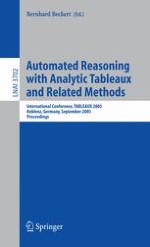2005 | Buch
Automated Reasoning with Analytic Tableaux and Related Methods
14th International Conference, TABLEAUX 2005, Koblenz, Germany, September 14-17, 2005. Proceedings
herausgegeben von: Bernhard Beckert
Verlag: Springer Berlin Heidelberg
Buchreihe : Lecture Notes in Computer Science
